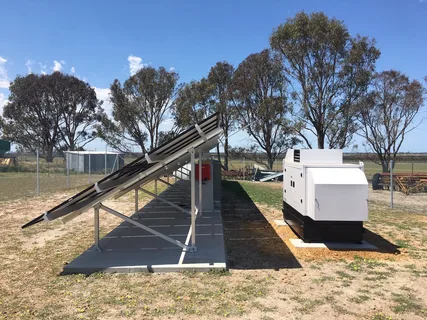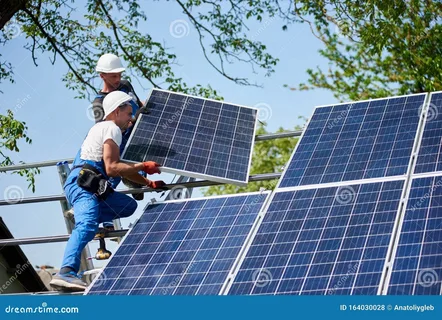In an era where energy independence and sustainability are more crucial than ever, stand alone power system (SAPS) emerge as a beacon of innovation. Imagine harnessing the sun’s rays or the wind’s whispers to generate electricity—no utility bills, no grid dependency, just pure, renewable power at your fingertips. Whether you’re looking to reduce your carbon footprint or seeking reliable energy in remote locations, understanding how these self-sufficient systems work can empower you to take control of your energy future; in this blog post, we’ll unravel the mechanics behind stand-alone power systems and explore why incorporating one into your lifestyle could be a game-changer for both you and the planet. Buckle up as we dive into the world of off-grid living!
Introduction to Stand Alone Power Systems
Imagine a world where you’re not tethered to the electric grid. A place where your power supply is entirely in your hands, free from utility bills and fluctuating energy prices. Welcome to the realm of stand alone power systems! These innovative setups offer more than just independence; they also promise sustainability and cost savings.
Whether you’re looking for an eco-friendly solution or want to escape the unpredictability of grid reliance, stand-alone power systems could be your answer. From remote cabins to off-grid living, these systems have opened doors for countless individuals seeking control over their energy sources. Let’s dive into how they work and explore why investing in one might be a game-changer for you!
How Stand Alone Power Supply Works
Stand-alone or off-grid power systems are independent energy sources that provide electricity to homes or buildings without being connected to the main power grid. These systems utilize a combination of renewable energy sources, such as solar panels, wind turbines, hydro generators, and batteries for storage and backup power. The basic principle behind stand alone power supply is simple: harnessing energy from the sun, wind or water and storing it in batteries when needed.
Solar panels convert sunlight into direct current (DC) electricity, which is then sent to an inverter that converts it into usable alternating current (AC) electricity. This AC electricity is then used to power appliances and devices in the home. Wind turbines work similarly by converting the wind’s kinetic energy into electrical energy through a generator. The generated electricity is also sent to an inverter for conversion and distribution to the home’s electrical system.
One key component of stand-alone power systems is battery storage. Batteries are crucial because they store excess energy produced during peak times for use when there is little or no renewable energy available. This allows for continuous access to electricity even when no sun shines or wind blows.
Components of a Stand-Alone System
A stand-alone power system comprises several key components that generate, store, and deliver electricity.
At the heart of the system are solar panels or wind turbines. These devices harness renewable energy from sunlight or wind, converting it into electrical power. Their efficiency is crucial for meeting energy demands.
Next is the battery storage unit. This component stores excess energy generated during peak production times when generation decreases, such as at night or on calm days.
An inverter plays a vital role in transforming direct current (DC) stored in batteries into alternating current (AC), which powers most household appliances.
Additionally, charge controllers manage the flow of electricity between these components, ensuring optimal operation and protecting against overcharging. Lastly, monitoring systems track performance data and help users effortlessly maximize their energy management strategy. Each part contributes to creating a reliable and efficient off-grid solution.
Benefits of Using Stand Alone Power Supply Systems
Stand alone power supply systems offer remarkable independence from traditional energy grids. This autonomy means you’re not affected by outages or fluctuations in electricity supply. These systems harness renewable resources like solar and wind, promoting sustainability and reducing your carbon footprint. By leaning on nature for energy, you contribute to a healthier planet. Lastly, owning a stand-alone system brings peace of mind in uncertain times—whether due to environmental concerns or economic shifts, you’re better prepared to face challenges head-on.
– Independence from the Grid
One of the most compelling reasons to invest in a stand-alone power system is its independence from traditional power grids. Imagine generating electricity free from fluctuating utility prices and potential outages. Living off-grid means you’re no longer at the mercy of external energy providers. You control your energy source, whether through solar panels or wind turbines. This autonomy can be liberating.
Additionally, during times of crisis or natural disasters when grid access may be compromised, a personal power system ensures that you remain unaffected. Your lights stay on, appliances function normally, and daily life continues uninterrupted. This freedom fosters a sense of security and self-sufficiency rarely found with conventional electrical systems. Embracing this lifestyle empowers individuals and encourages communities to explore sustainable practices collectively.
– Sustainability and Environmental Impact
Stand-alone power systems shine in their ability to promote sustainability. They harness renewable energy sources like solar and wind, reducing reliance on fossil fuels. By generating electricity locally, these systems help lower carbon footprints significantly. Every kilowatt produced from sunshine or wind means one less from non-renewable sources. Moreover, they encourage a more efficient use of resources. You’ll likely adopt energy-saving practices when you generate your power.
Many stand-alone setups come with battery storage technology that optimizes energy use throughout the day and night. This ensures that excess energy isn’t wasted but rather saved for future needs. As communities increasingly seek green solutions, adopting stand-alone power systems becomes attractive for individuals and businesses committed to environmental stewardship.
– Cost Savings in the Long Run
Investing in a stand-alone power system can significantly reduce long-term energy costs. While the initial setup may require capital, the savings over time are undeniable. With rising electricity prices, self-sufficiency allows you to avoid these increasing rates altogether. You generate your power, so you’re not at the mercy of utility companies.
Additionally, maintenance costs for renewable systems like solar panels are relatively low compared to traditional energy sources. Once installed, they often require minimal upkeep while providing free energy for years. Moreover, many regions offer incentives or tax credits for using renewable technologies. This can help offset installation expenses and further enhance your savings. As you rely less on grid electricity, unexpected outages won’t impact your budget either. The peace of mind that comes with knowing you have a stable energy source is invaluable.
Considerations Before Installing a Stand Alone Energy System
The real important factors must be considered. T when installing stand alone energy system can be a great option for those looking to reduce their reliance on the traditional power grid or for remote locations where access to electricity may be limited. However, before deciding to install one, it is essential to carefully consider these key aspects.
 Energy Needs and Usage
Energy Needs and Usage
The first consideration when installing a stand-alone energy system is assessing your energy needs and usage. This includes identifying the appliances and devices the system will power and estimating their daily and seasonal usage. This information will help determine the size and type of system best suits your needs.
Location and Climate
Location plays a crucial role in deciding which type of stand-alone energy system is most suitable. For instance, solar panels work best in areas with abundant sunlight, while wind turbines require consistent wind speeds for optimal performance. It is also important to consider the climate of your location, as extreme temperatures or harsh weather conditions can impact the efficiency of certain systems.
Budget and Maintenance Costs
Stand-alone energy systems can be a significant investment upfront; however, they can also provide long-term cost savings by reducing or eliminating monthly utility bills. Before installation, you must assess your budget and determine what amount you will spend initially on the system and ongoing maintenance costs.
System Components
A stand-alone energy system typically consists of components such as solar panels, batteries, inverters, charge controllers, generators (if needed), etc. Researching these components thoroughly before making any installation decisions is crucial. Factors such as quality, durability, and warranty periods must be considered when selecting components for your system.
Key Features of Stand Alone Power Systems
Stand alone power systems (SAPS) are becoming increasingly popular as a reliable and cost-effective energy solution for off-grid homes, businesses, and remote areas. Unlike traditional grid-connected systems that rely on a centralized power source, SAPS independently generate electricity through renewable sources like solar panels, wind turbines, or hydro systems. This means they are not dependent on the main power grid and can provide uninterrupted energy supply even in the most remote locations.
But what exactly makes SAPS such an attractive option? Let’s take a closer look at some of their key features.
Independence from the main power grid
One of the most significant advantages of SAPS is its ability to function independently from the main power grid. This means that even if there is a blackout or disruption in the central power supply, your home or business will still have access to electricity without interruptions. This feature is particularly beneficial for rural or remote areas where connecting to the main grid may be expensive or unreliable.
Renewable energy sources
Another essential feature of SAPS is its use of renewable energy sources like solar, wind, and hydro systems to generate electricity. These sources are cleaner and more sustainable than traditional fossil fuels, making them an eco-friendly alternative for powering your home or business. Moreover, since these resources are readily available and free, investing in a SAPS can significantly reduce energy expenses.
Customizable to suit individual needs
Unlike traditional grid-connected systems, where you must adhere to set regulations and restrictions regarding energy usage, SAPS offer greater flexibility as they can be customized according to individual needs. You can choose which renewable resource you want based on location, climate conditions, and budgetary constraints.
Scalable
Another key feature of SAPs is their scalability options – meaning they can easily expand or downsize based on your changing energy demands. You can add more solar panels or wind turbines to your system if you need more power. Similarly, if your energy needs decrease, you can reduce the number of panels or turbines accordingly.
Conclusion
Stand-alone power systems are a reliable and sustainable option for off-grid living or as a backup to traditional grid-tied systems. They offer independence from fluctuating electricity prices, power outages, and reliance on fossil fuels. By generating and storing your energy, you can reduce your carbon footprint and save money in the long run.
FAQs:
Q: How much does it cost to install a stand-alone power system?
A: The cost of installing a stand-alone power system varies depending on the size of the system, the components used, and any additional features such as backup generators or advanced monitoring systems. On average, a basic off-grid system for a small household can cost anywhere from $10,000-$20,000.
Q: Can I still use appliances requiring high energy with a stand-alone power system?
A: Yes, but it is important to carefully consider your energy needs before choosing which appliances to use. Heavy-duty appliances like air conditioners or electric cars require larger solar panels and battery storage capacity to function efficiently.
Q: Do I need special knowledge or skills to maintain my stand-alone power system?
A: Basic knowledge of electrical systems is recommended for troubleshooting purposes. However, most reputable installation companies offer maintenance services and warranties for their systems, so you don’t have to worry about complicated maintenance tasks.
| Other Good Articles to Read |
| Skank Blogs |
| Unreal Blogs |
| Tba Blogs |
| All City Forums |
| Dany Blogs |
| Refuge Blogs |
| The Music Blogs |
| Key Forums |
| The Big Blog Theory |
| Joe Blogs |
| Blogs 4 Me |
| Blogs Emon |
| Related Business Listings |
| Contact Directory |
| Local Business Profiles |


